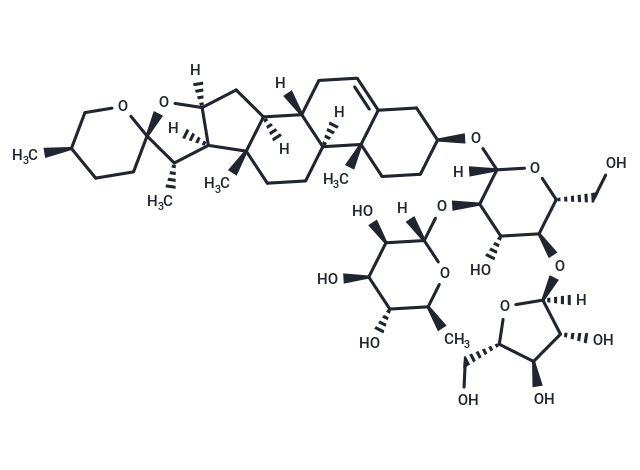Shopping Cart
- Remove All
 Your shopping cart is currently empty
Your shopping cart is currently empty

Polyphyllin D induces apoptosis via the mitochondrial apoptotic pathway as evidenced by decreased Bcl-2 expression levels, disruption of MMP and increased Bax, cytochrome C, and cleaved-caspase-3 levels. Polyphyllin D has an anti-angiogenic effect. Polyphyllin D has toxicity in human RBCs as well as its underlying mechanism for the hemolysis and eryptosis/erythroptosis. Polyphyllin D has strong anticancer activity, can overcome drug resistance in R-HepG2 cells and elicit programmed cell death via mitochondrial dysfunction.

| Pack Size | Price | Availability | Quantity |
|---|---|---|---|
| 5 mg | $52 | In Stock | |
| 10 mg | $89 | In Stock | |
| 25 mg | $153 | In Stock | |
| 50 mg | $238 | In Stock | |
| 100 mg | $397 | In Stock |
| Description | Polyphyllin D induces apoptosis via the mitochondrial apoptotic pathway as evidenced by decreased Bcl-2 expression levels, disruption of MMP and increased Bax, cytochrome C, and cleaved-caspase-3 levels. Polyphyllin D has an anti-angiogenic effect. Polyphyllin D has toxicity in human RBCs as well as its underlying mechanism for the hemolysis and eryptosis/erythroptosis. Polyphyllin D has strong anticancer activity, can overcome drug resistance in R-HepG2 cells and elicit programmed cell death via mitochondrial dysfunction. |
| Molecular Weight | 855.02 |
| Formula | C44H70O16 |
| Cas No. | 50773-41-6 |
| Smiles | [H][C@]12C[C@@]3([H])[C@]4([H])CC=C5C[C@H](CC[C@]5(C)[C@@]4([H])CC[C@]3(C)[C@@]1([H])[C@H](C)[C@@]1(CC[C@@H](C)CO1)O2)O[C@]1([H])O[C@H](CO)[C@@H](O[C@]2([H])O[C@@H](CO)[C@H](O)[C@H]2O)[C@H](O)[C@H]1O[C@]1([H])O[C@@H](C)[C@H](O)[C@@H](O)[C@H]1O |
| Relative Density. | 1.4 |
| Storage | Powder: -20°C for 3 years | In solvent: -80°C for 1 year | Shipping with blue ice. | ||||||||||||||||||||||||||||||
| Solubility Information | DMSO: 55 mg/mL (64.33 mM), Sonication is recommended. | ||||||||||||||||||||||||||||||
Solution Preparation Table | |||||||||||||||||||||||||||||||
DMSO
| |||||||||||||||||||||||||||||||

Copyright © 2015-2025 TargetMol Chemicals Inc. All Rights Reserved.